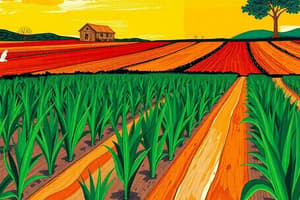Podcast
Questions and Answers
What is the first step in crop production?
What is the first step in crop production?
- Controlling weeds and pests
- Harvesting the crops
- Processing the final product
- Planting seeds (correct)
Why is irrigation important in crop production?
Why is irrigation important in crop production?
- To control weed growth
- To optimize fertilizer application
- To ensure adequate water supply for the crop (correct)
- To manage seedling emergence
What is the purpose of fertilizers in crop production?
What is the purpose of fertilizers in crop production?
- To provide essential nutrients for crop growth (correct)
- To ensure optimal seedling emergence
- To control pest infestations
- To reduce water loss through evaporation
What does seedling management involve?
What does seedling management involve?
Why is proper seedbed preparation essential in crop production?
Why is proper seedbed preparation essential in crop production?
What is an example of an integrated pest management approach mentioned in the text?
What is an example of an integrated pest management approach mentioned in the text?
What are the three primary nutrients required by crops?
What are the three primary nutrients required by crops?
Which step is essential for maximizing crop yield and quality?
Which step is essential for maximizing crop yield and quality?
What is the purpose of implementing sustainable farming practices?
What is the purpose of implementing sustainable farming practices?
Which strategy aims to improve agricultural productivity and resilience in the face of climate change?
Which strategy aims to improve agricultural productivity and resilience in the face of climate change?
Flashcards are hidden until you start studying
Study Notes
Crop Production and Management
Crop production and management is a crucial aspect of agriculture, involving the cultivation, harvesting, and processing of crops to ensure a reliable and sustainable food supply. It involves various stages, from planting seeds to harvesting and processing the final product. In this article, we will discuss the different steps involved in crop production and management, as well as the challenges and strategies for optimizing crop yields.
Planting and Seedling Management
The first step in crop production is planting seeds. Seeds are sown at a specific depth and spacing depending on the crop type and soil conditions. Proper seedbed preparation, including tillage and fertilizer application, is essential for optimal seedling emergence and growth. Seedling management involves monitoring and controlling weeds, pests, and diseases during the early stages of crop growth.
Irrigation and Water Management
Irrigation is a critical component of crop production, especially in arid regions or during periods of drought. Irrigation systems, such as sprinklers or drip irrigation, are used to supply water to crops. Proper water management is essential for maintaining soil moisture levels, reducing water loss through evaporation, and ensuring adequate water supply for the crop.
Fertilization and Nutrient Management
Fertilizers are applied to provide essential nutrients for crop growth. Nitrogen, phosphorus, and potassium are the three primary nutrients required by crops, but secondary and micronutrients are also important. Fertilizer application rates and timing are crucial for optimizing crop yields and minimizing environmental impacts.
Pest and Disease Management
Crop production and management also involve monitoring and controlling pests and diseases that threaten crop health and productivity. Integrated pest management approaches, including the use of biological controls and resistant varieties, can help reduce the reliance on chemical pesticides and minimize the negative impact on the environment.
Harvesting and Post-Harvest Management
Harvesting is the final step in crop production, involving the collection of mature crops from the field. Proper harvesting techniques are essential for maximizing crop yield and quality. Post-harvest management involves storage, processing, and transportation of crops to ensure their quality and availability for consumers.
Challenges and Strategies in Crop Production and Management
Crop production and management face several challenges, including climate change, increasing demand for food, and environmental sustainability. Strategies for mitigating these challenges include:
-
Sustainable farming practices: Implementing sustainable farming practices, such as crop rotation, reduced tillage, and integrated pest management, can help improve soil health, reduce environmental impacts, and maintain crop productivity.
-
Innovation in technology: Advancements in technology, such as precision agriculture and automation, can help optimize crop production and management, reduce labor costs, and minimize environmental impacts.
-
Climate-smart agriculture: Adopting climate-smart agriculture practices, such as water conservation, soil carbon sequestration, and renewable energy use, can help improve agricultural productivity and resilience in the face of climate change.
-
Collaboration and knowledge sharing: Collaboration among farmers, policymakers, and researchers can help improve crop production and management practices, share knowledge, and promote innovation in the sector.
In conclusion, crop production and management is a complex and multifaceted process that requires careful planning, monitoring, and control. By addressing the challenges and implementing strategies for optimization and sustainability, we can ensure a reliable and sustainable food supply for future generations.
Studying That Suits You
Use AI to generate personalized quizzes and flashcards to suit your learning preferences.




